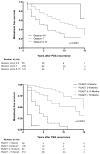The natural history of metastatic progression in men with prostate-specific antigen recurrence after radical prostatectomy: long-term follow-up
- PMID: 21777360
- PMCID: PMC3204323
- DOI: 10.1111/j.1464-410X.2011.10422.x
The natural history of metastatic progression in men with prostate-specific antigen recurrence after radical prostatectomy: long-term follow-up
Abstract
Objective: To describe metastasis-free survival (MFS) in men with prostate-specific antigen (PSA) recurrence following radical prostatectomy, and to define clinical prognostic factors modifying metastatic risk.
Patients and methods: We conducted a retrospective analysis of 450 men treated with prostatectomy at a tertiary hospital between July 1981 and July 2010 who developed PSA recurrence (≥0.2 ng/mL) and never received adjuvant or salvage therapy before the development of metastatic disease. We estimated MFS using the Kaplan-Meier method, and investigated factors influencing the risk of metastasis using Cox proportional hazards regression.
Results: Median follow-up after prostatectomy was 8.0 years, and after biochemical recurrence was 4.0 years. At last follow-up, 134 of 450 patients (29.8%) had developed metastases, while median MFS was 10.0 years. Using multivariable regressions, two variables emerged as independently predictive of MFS: PSA doubling time (<3.0 vs 3.0-8.9 vs 9.0-14.9 vs ≥15.0 months) and Gleason score (≤6 vs 7 vs 8-10). Using these stratifications of Gleason score and PSA doubling time, tables were constructed to predict median, 5- and 10-year MFS after PSA recurrence. In different patient subsets, median MFS ranged from 1 to 15 years.
Conclusions: In men undergoing prostatectomy, MFS after PSA recurrence is variable and is most strongly influenced by PSA doubling time and Gleason score. These parameters serve to stratify men into different risk groups with respect to metastatic progression. Our findings may provide the background for appropriate selection of patients, treatments and endpoints for clinical trials.
© 2011 THE AUTHORS. BJU INTERNATIONAL © 2011 BJU INTERNATIONAL.
Conflict of interest statement
This work is original, and was presented orally at the 2009 ASCO Genitourinary Cancer Symposium and at the 2009 ASCO Annual Meeting. The authors indicate no financial or other conflicts of interest.
Figures
Comment in
-
Re: The natural history of metastatic progression in men with prostate-specific antigen recurrence after radical prostatectomy: long-term follow-up.J Urol. 2012 Sep;188(3):809. doi: 10.1016/j.juro.2012.05.064. Epub 2012 Jul 20. J Urol. 2012. PMID: 22883757 No abstract available.
References
-
- Jemal A, Siegel R, Xu J, Ward E. Cancer statistics, 2010. CA Cancer J Clin. 2010;60:277–300. - PubMed
-
- Roehl KA, Han M, Ramos CG, Antenor JA, Catalona WJ. Cancer progression and survival rates following anatomical radical retropubic prostatectomy in 3,478 consecutive patients: long-term results. J Urol. 2004;172:910–14. - PubMed
-
- Freedland SJ, Humphreys EB, Mangold LA, et al. Risk of prostate cancer-specific mortality following biochemical recurrence after radical prostatectomy. JAMA. 2005;294:433–9. - PubMed
-
- Moul JW, Banez LL, Freedland SJ. Rising PSA in nonmetastatic prostate cancer. Oncology. 2007;21:1436–45. - PubMed
-
- Sandler HM, Eisenberger MA. Assessing and treating patients with increasing prostate specific antigen following radical prostatectomy. J Urol. 2007;178:S20–4. - PubMed
Publication types
MeSH terms
Substances
Grants and funding
LinkOut - more resources
Full Text Sources
Other Literature Sources
Medical
Research Materials
Miscellaneous




